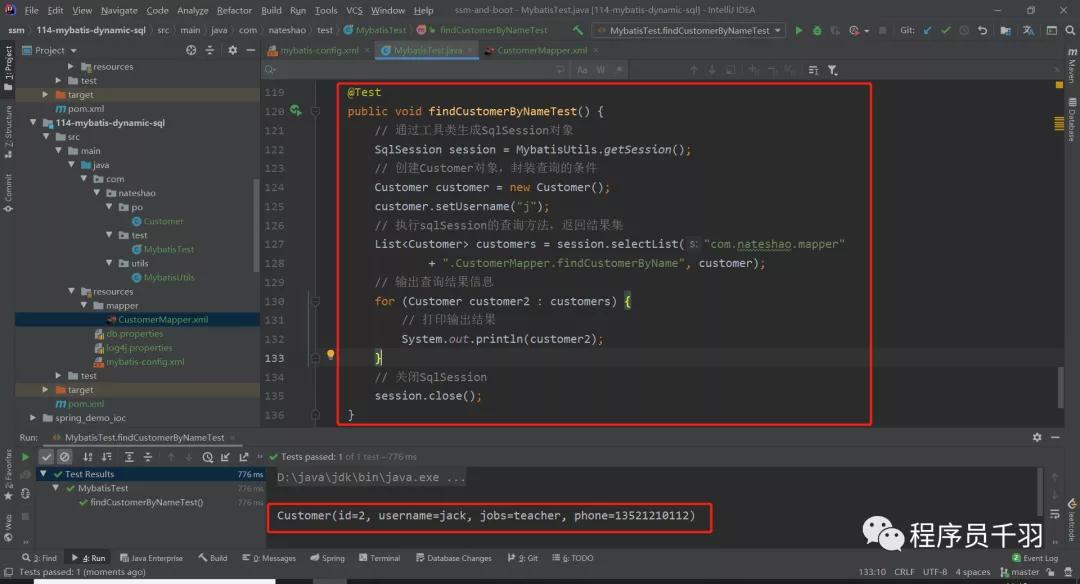1. 动态SQL中的元素
动态SQL有什么作用?
“开发人员在使用JDBC或其他类似的框架进行数据库开发时,通常都要根据需求去手动拼装SQL,这是一个非常麻烦且痛苦的工作,而MyBatis提供的对SQL语句动态组装的功能,恰能很好的解决这一麻烦工作。
动态SQL是MyBatis的强大特性之一,MyBatis3采用了功能强大的基于OGNL的表达式来完成动态SQL。动态SQL主要元素如下表所示:
2. < if >元素
“在MyBatis中,< if >元素是最常用的判断语句,它类似于Java中的if语句,主要用于实现某些简单的条件选择。其基本使用示例如下:
- select * from t_customer where 1=1
- <if test="username !=null and username !=''">
- and username like concat('%',#{username}, '%')
- </if>
- <if test="jobs !=null and jobs !=''">
- and jobs= #{jobs}
- </if>
使用< if >元素对username和jobs进行非空判断,并动态组装SQL
“在实际应用中,我们可能会通过多个条件来精确的查询某个数据。例如,要查找某个客户的信息,可以通过姓名和职业来查找客户,也可以不填写职业直接通过姓名来查找客户,还可以都不填写而查询出所有客户,此时姓名和职业就是非必须条件。
3. < choose >及其子元素
- <!--<choose>(<when>、<otherwise>)元素使用 -->
- <select id="findCustomerByNameOrJobs" parameterType="com.nateshao.po.Customer"
- resultType="com.nateshao.po.Customer">
- select * from t_customer where 1=1
- <choose>
- <when test="username !=null and username !=''">
- and username like concat('%',#{username}, '%')
- </when>
- <when test="jobs !=null and jobs !=''">
- and jobs= #{jobs}
- </when>
- <otherwise>
- and phone is not null
- </otherwise>
- </choose>
- </select>
使用< choose >及其子元素依次对条件进行非空判断,并动态组装SQL。
4. < when >、< trim >元素
在前面中,映射文件中编写的SQL后面都加入了“where 1=1”的条件,那么到底为什么要这么写呢?如果将where后“1=1”的条件去掉,那么MyBatis所拼接出来的SQL将会如下所示:
- select * from t_customer where and username like concat('%',?, '%')
可以看出上面SQL语句明显存在SQL语法错误,而加入了条件“1=1”后,既保证了where后面的条件成立,又避免了where后面第一个词是and或者or之类的关键词。不过“where 1=1”这种写法对于初学者来将不容易理解,并且也不够雅观。
针对上述情况中“where 1=1”,在MyBatis的SQL中就可以使用< where >或< trim >元素进行动态处理。
动态SQL处理
- select * from t_customer
- <where>
- <if test="username !=null and username !=''">
- and username like concat('%',#{username}, '%')
- </if>
- <if test="jobs !=null and jobs !=''">
- and jobs= #{jobs}
- </if>
- </where>
< where >元素处理
< where >会自动判断SQL语句,只有< where >内的条件成立时,才会在拼接SQL中加入where关键字,否则将不会添加;还会去除多余的“AND”或“OR”。
- select * from t_customer
- <trim prefix="where" prefixOverrides="and">
- <if test="username !=null and username !=''">
- and username like concat('%',#{username}, '%')
- </if>
- <if test="jobs !=null and jobs !=''">
- and jobs= #{jobs}
- </if>
- </trim>
5. < set >元素
“在Hibernate中,想要更新某个对象,就需要发送所有的字段给持久化对象,这种想更新的每一条数据都要将其所有的属性都更新一遍的方法,其执行效率是非常差的。为此,在MyBatis中可以使用动态SQL中的< set >元素进行处理:
- <!-- <set>元素 -->
- <update id="updateCustomer" parameterType="com.nateshao.po.Customer">
- update t_customer
- <set>
- <if test="username !=null and username !=''">
- username=#{username},
- </if>
- <if test="jobs !=null and jobs !=''">
- jobs=#{jobs},
- </if>
- <if test="phone !=null and phone !=''">
- phone=#{phone},
- </if>
- </set>
- where id=#{id}
- </update>
使用< set >和< if >元素对username和jobs进行更新判断,并动态组装SQL。这样就只需要传入想要更新的字段即可
代码实现:
6. < foreach >元素
假设如下需求:在一个客户表中有1000条数据,现在需要将id值小于100的客户信息全部查询出来,这要怎么做呢?
一条一条的查询 :那如果要查询1000条数据呢,岂不是很累?
在Java中用for循环查询 :考虑过N条查询语句时的查询效率了吗?
针对上述需求,理想的解决方法就是使用MyBatis中动态SQL的< foreach >元素进行处理。其基本使用示例如下所示:
- <!--<foreach>元素使用 -->
- <select id="findCustomerByIds" parameterType="List"
- resultType="com.nateshao.po.Customer">
- select * from t_customer where id in
- <foreach item="id" index="index" collection="list" open="("
- separator="," close=")">
- #{id}
- </foreach>
- </select>
关于上述示例中< foreach >元素中使用的几种属性的描述具体如下:
- item:配置的是循环中当前的元素。
- index:配置的是当前元素在集合的位置下标。
- collection:配置的list是传递过来的参数类型(首字母小写),它可以是一个array、list(或collection)、Map集合的键、POJO包装类中数组或集合类型的属性名等。
- open和close:配置的是以什么符号将这些集合元素包装起来。
- separator:配置的是各个元素的间隔符。
在使用< foreach >时最关键也是最容易出错的就是collection属性,该属性是必须指定的,而且在不同情况下,该属性的值是不一样的。主要有以下3种情况:
- 如果传入的是单参数且参数类型是一个数组或者List的时候,collection属性值分别为array和list(或collection)。
- 如果传入的参数是多个的时候,就需要把它们封装成一个Map了,当然单参数也可以封装成Map集合,这时候collection属性值就为Map的键。
- 如果传入的参数是POJO包装类的时候,collection属性值就为该包装类中需要进行遍历的数组或集合的属性名。
7. < bind >元素
在入门案例中模糊查询的SQL语句中?
- select * from t_customer where username like '%${value}%'
上述SQL语句有什么不妥?
- 如果使用“${}”进行字符串拼接,则无法防止SQL注入问题;
- 如果改用concat函数进行拼接,则只针对MySQL数据库有效;
- 如果改用“||”进行字符串拼接,则只针对Oracle数据库有效。
小提示:这样,映射文件中的SQL就要根据不同的情况提供不同形式的实现,这显然是比较麻烦的,且不利于项目的移植。为了减少这种麻烦,就可以使用MyBatis的< bind >元素来解决这一问题。
MyBatis的< bind >元素可以通过OGNL表达式来创建一个上下文变量,其使用方式如下:
- <!--<bind>元素的使用:根据客户名模糊查询客户信息 -->
- <select id="findCustomerByName" parameterType="com.nateshao.po.Customer"
- resultType="com.nateshao.po.Customer">
- <!--_parameter.getUsername()也可直接写成传入的字段属性名,即username -->
- <bind name="pattern_username" value="'%'+_parameter.getUsername()+'%'"/>
- select * from t_customer
- where
- username like #{pattern_username}
- </select>
_parameter.getUsername()表示传递进来的参数(也可以直接写成对应的参数变量名,如username)。
总结
好了,最后我们可以了解常用动态SQL元素的主要作用,并能够掌握这些元素在实际开发中如何使用。因为千羽在实际开发MyBatis框架中,这些动态SQL元素的使用十分重要,熟练的掌握它们能够极大的提高开发效率。






























